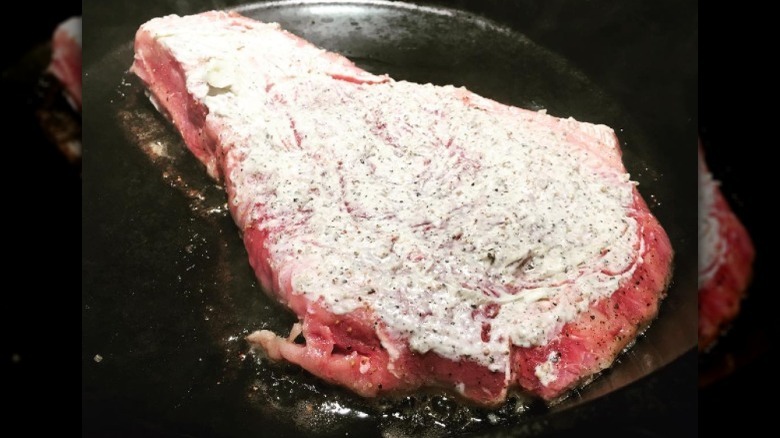The Unconventional Condiment Alton Brown Says You Can Cook Steak With
Steak is a staple for most meat eaters in the United States. If you eat beef, chances are it is to the tune of 55 pounds a year, per Comfy Living, and no doubt, steak is up there when it comes to preference. In fact, Alton Brown once quipped, "You know, I think it's safe to say John Wayne ate steak. I mean, if there's a meal more fundamentally American we can't think of it. I mean, steak is a food borne of wide open spaces and big skies..." (via Good Eats Fan Page).
Brown is a carnivore who knows how to cook a steak. Whether the celebrity chef is on one of his Food Network shows touting the virtues of his pan-seared rib-eye and the beautiful crust he is able to achieve in 30-seconds on the stovetop or providing a master class on how to make reverse-sear filet mignon that you can watch over and over again on Youtube, his understanding of how to work with this beloved meat is unmatched. To wit, Brown has shared a seemingly unconventional condiment you can use to cook your steak in pursuit of culinary excellence and a mouthwatering bite of beef.
Break out the mayo
Alton Brown took to his Instagram platform to share that if you find yourself without butter or oil, you can always use some mayo as the fat to cook your steak in. If you aren't a fan of this condiment, you might want to reconsider, that is, if you like steak. The trend of using mayo as a frying fat really took off with the grilled cheese but has definitely spread.
The New York Times concurs with Brown, explaining that not only does it serve as a cooking fat, but when you "slather" a layer of mayo on each side of your steak, it becomes a wonderful marinade for your meat, imparting a pop of flavor. This is especially true when mayo is mixed with some of your traditional marinades like chimichurri and barbecue sauce. Why does it work so well?
The Los Angeles Times reveals this sandwich condiment consists primarily of eggs and oil, with the protein from the egg contributing to the Maillard reaction. This reaction ultimately helps to create that beautiful golden crust that is a hallmark of a well-cooked steak, but it does it better. The New York Times further laments how this quality of mayo comes in handy when you don't want to cook those thinner steak cuts for an extended period of time and risk dry, chewy bites.

